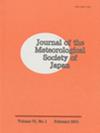A Machine Learning Approach to the Observation Operator for Satellite Radiance Data Assimilation
IF 1.6
4区 地球科学
Q3 METEOROLOGY & ATMOSPHERIC SCIENCES
引用次数: 2
Abstract
The observation operator (OO) is essential in data assimilation (DA) to derive the model equivalent of observations from the model variables. In the satellite DA, the OO for satellite microwave brightness temperature (BT) is usually based on the radiative transfer model (RTM) with a bias correction procedure. To explore the possibility to obtain OO without using physically based RTM, this study applied machine learning (ML) as OO (MLOO) to assimilate BT from Advanced Microwave Sounding Unit-A (AMSU-A) channels 6 and 7 over oceans and channel 8 over both land and oceans under clear-sky conditions. We used a reference system, consisting of the nonhydrostatic icosahedral atmospheric model (NICAM) and the local ensemble transform Kalman filter (LETKF). The radiative transfer for TOVS (RTTOV) was implemented in the system as OO, combined with a separate bias correction procedure (RTTOV-OO). The DA experiment was performed for 1 month to assimilate conventional observations and BT using the reference system. Model forecasts from the experiment were paired with observations for training the ML models to obtain ML-OO. In addition, three DA experiments were conducted, which revealed that DA of the conventional observations and BT using ML-OO was slightly inferior, compared to that of RTTOV-OO, but it was better than the assimilation based on only conventional observations. Moreover, ML-OO treated bias internally, thereby simplifying the overall system framework. The proposed ML-OO has limitations due to (1) the inability to treat bias realistically when a significant change is present in the satellite characteristics, (2) inapplicability for many channels, (3) deteriorated performance, compared with that of RTTOV-OO with respect to accuracy and computational speed, and (4) physically based RTM is still used to train the ML-OO. Future studies can alleviate these drawbacks, thereby improving the proposed ML-OO.卫星辐射数据同化观测算子的机器学习方法
在数据同化(DA)中,观测算子从模型变量中导出观测值的模型等价是必不可少的。在卫星数据分析中,卫星微波亮度温度(BT)的OO通常是基于辐射传输模型(RTM)并进行偏置校正。为了探索在不使用基于物理的RTM的情况下获得OO的可能性,本研究应用机器学习(ML)作为OO (MLOO)来吸收来自先进微波探测单元- a (AMSU-A)在海洋上的6和7频道以及晴天条件下陆地和海洋上的8频道的BT。我们使用了一个由非流体静力二十面体大气模型(NICAM)和局部系综变换卡尔曼滤波(LETKF)组成的参考系统。TOVS的辐射传递(RTTOV)在系统中作为OO实现,并结合单独的偏置校正程序(RTTOV-OO)。采用参考系统进行了为期1个月的DA实验,以同化常规观测和BT。从实验中得到的模型预测与观测结果配对,用于训练ML模型以获得ML- oo。此外,进行了3次数据同化实验,结果表明,与RTTOV-OO同化相比,使用ML-OO同化常规观测值和BT的数据同化效果略差,但优于仅使用常规观测值同化。此外,ML-OO在内部处理了偏差,从而简化了整个系统框架。所提出的ML-OO存在以下局限性:(1)当卫星特性发生重大变化时,无法真实地处理偏差;(2)不适用于许多信道;(3)与RTTOV-OO相比,性能在精度和计算速度方面有所下降;(4)仍然使用基于物理的RTM来训练ML-OO。未来的研究可以减轻这些缺点,从而改进所提出的ML-OO。
本文章由计算机程序翻译,如有差异,请以英文原文为准。
求助全文
约1分钟内获得全文
求助全文
来源期刊
CiteScore
6.70
自引率
16.10%
发文量
56
审稿时长
3 months
期刊介绍:
JMSJ publishes Articles and Notes and Correspondence that report novel scientific discoveries or technical developments that advance understanding in meteorology and related sciences. The journal’s broad scope includes meteorological observations, modeling, data assimilation, analyses, global and regional climate research, satellite remote sensing, chemistry and transport, and dynamic meteorology including geophysical fluid dynamics. In particular, JMSJ welcomes papers related to Asian monsoons, climate and mesoscale models, and numerical weather forecasts. Insightful and well-structured original Review Articles that describe the advances and challenges in meteorology and related sciences are also welcome.

 求助内容:
求助内容: 应助结果提醒方式:
应助结果提醒方式:


